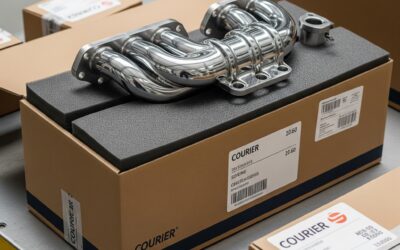Are you looking to ship a package within Canada? Whether you’re shipping a gift for a loved one or trying to get your online store products delivered, this guide will teach you everything you need to know about shipping in Canada. We’ll cover how to prepare your package for shipping, the different types of shipping services available, and how to get the best rates on shipping. Let’s get started!
A step-by-step guide to shipping within Canada
Do you need to ship something from Canada? Whether you’re sending a package to a friend or sending commercial goods, shipping can be a bit confusing. Here’s a quick guide to help you get started.
1. Know the requirements – what can and cannot be shipped, and any special documentation needed
2. Choose your shipping method – air, ground, or rail
3. Pack your shipment carefully, using the proper materials
4. Calculate the shipping costs – weight, distance, and insurance
5. Ship your package to the right address – with a complete and accurate label
6. Track your shipment, so you know when it arrives safely
Now that you know the basics of shipping in Canada, you’re ready to start sending out parcels quickly and cost-effectively.
A step-by-step guide to shipping in Canada
A step-by-step guide to shipping within Canada. Everything you need to know about shipping regulations, customs clearance, and more. Whether you’re a business owner or an individual shipper, this guide will help you get your shipments across the border without any headaches. Let’s get started!
1. Gather the necessary paperwork – you’ll need a bill of lading, commercial invoice, and other documents depending on the type of shipment
When it comes to shipping goods, it pays to be prepared. Knowing what paperwork will be needed in advance helps to ensure that cargo arrives at its destination on time and without incident. Most haulers require a bill of lading, a commercial invoice, and other documentation depending on the type of shipment you are making. For example, if sending hazardous materials or armor-piercing items, additional certificates or documents may be required. Additionally, when transporting goods in the European Union, you will need the necessary customs forms for clearance in each country. It’s always best practice to have these documents ready before you make your shipment; not only will you save time, but having everything readily available also reduces potential delays and avoids delivery difficulties caused by missing paperwork. By gathering the necessary documents in advance, you can be sure that every shipment is an efficient and precisely managed operation.
2. Choose your shipping method – will you ship by air, ocean, or ground?
Making the decision to choose a shipping method can be daunting – what works best for your goods and gets them to their destination in the most efficient way? Generally, goods being shipped short distances choose air travel; ocean freight works best for items being delivered overseas or between large countries; while ground transportation is best for shorter routes within a country or region. Air travel has the advantage of being relatively fast, but is usually more expensive than other methods. It’s important to consider whether the saved days for your delivery will offset any additional costs associated with air shipment. Ocean freight offers longer delivery times but s generally much cheaper than air transport. There are options regarding container size too – from standard 20- and 40-foot containers to smaller specialty containers – making it easier to move items that wouldn’t fit in larger containers. Finally, if you need your delivery to arrive at its destination soon, ground transportation offers an economical solution and can ensure goods arrive on time. Whichever method you choose, there are suitable vehicles and modes of transport available so many shipments can benefit from the latest tracking technologies, making for a smoother process overall. So when it comes time to choose your shipping method make sure you weigh up all the pros and cons before deciding which option works best for you!
3. Pack your shipment carefully – use strong boxes and packing material to prevent damage in transit
Shipping items can require a great deal of care and attention, particularly when the package contains valuable or fragile goods. Choosing the right box is essential for keeping items secure on their journey – weak boxes will break quickly and cause items to shift in transit, resulting in damage. The box should be strong enough to bear any rough handling by carriers, as well as inclement weather if exposed unexpectedly. Packing material also plays an important role. Smaller items should be wrapped securely in newspaper, bubble wrap or plastic packaging – this will help cushion them from vibration and unexpected bumps during transit. Foam padding can also provide additional protection for heavier or more delicate items which may be easily damaged. By taking the time to pack your shipment carefully, you can rest assured that it will arrive safe and sound at its destination!
4. Label your shipment clearly and include all required information
When shipping goods, it’s essential to provide clear, accurate information. Not only does this help you keep track of your shipments and monitor their progress, but it can also prevent dangerous delays and miscommunications in the transportation process. Make sure that you always clearly label each shipment with the required documentation. This should include both the sender and receiver’s names, account numbers, tracking numbers, descriptions of the content (including its weight and size), delivery address, invoice number (if applicable) and any other pertinent information. Additionally, be sure to clearly mark the package itself with “handle with care” instructions or any other relevant notices. Taking a few moments to properly label your shipment at the outset can save a great deal of hassle down the line. Stay organized and make sure all necessary information is included on every shipment!
Complete documentation not only helps streamline processes within your own business — it can also help your recipient fast-track receiving their packages correctly and on time. They’ll be assured that their deliveries are safe from damage and confusion due to insufficient labeling or mismatched data; following these steps will help protect them from any unnecessary delays or errors in delivery. Proper labeling is easy to overlook amid all of the other important considerations for successful shipping — but it should never be forgotten! Make sure to stay vigilant about every element of your packages’ paperwork for safe transport.
5. Drop off your shipment at the shipping company’s office or have them pick it up from your location
When you need to move a shipment quickly and hassle-free, turning to a reliable shipping company is the way to go. Depending on your needs, it can often be more efficient and cost-effective for them to pick up the shipment at your location rather than for you to drop it off at their office. Many reputable companies offer this type of “door-to-door” service so that you don’t have to worry about getting your package from point A to point B—the company handles all of the logistics from pick up to delivery. For example, they may be able to send out a driver who will come and pick up your package and take it back to their depot for transport. Keep in mind though that there are certain conditions that would determine which option is more suitable for you. For instance, if time is of the essence or you need a specific service like signature confirmation that only an office dropoff can provide, then dropping off at the shipping company’s office would be best. Overall, with careful consideration of your shipment’s parameters and access to the right resources and services, either option should work perfectly for meeting both your expectations and budget constraints.
Shipping can be a complex process, but following these steps will help make it simpler. If you need assistance with your shipment, ShipSimple.ca is here to help. We offer reduced shipping rates and can take care of all the details for you. Request a quote today and see how much you can save on your next shipment.





